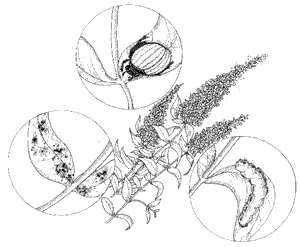 |
The Shrub Looks Old or Has Small Flowers - Needs Pruning
Butterfly bush branches that survive winters become stiff and woody after their first season. They produce smaller flowers. Keep these shrubs healthy by pruning back the stems each fall to about 4 inches. In the spring the shrub will send out new, vigorous stems that will produce normal-sized flowers. Cut off, or deadhead, the faded blooms as the summer progresses to encourage repeat blooming all season.
Leaves Are Chewed, Even Skeletonized by Japanese Beetles
Japanese beetles are 1/2 inch long with shiny, metallic green and copper-brown wing covers. Their larvae (white grubs) are grayish white worms with dark brown heads. Beetles emerge from the soil or lawn at the end of June or early July and proceed to eat butterfly bush leaves and/or flowers. They make holes on the edges and in the middle of the leaves, leaving only the veins in some cases. If you catch them early, handpicking them and dropping them into a jar of soapy water will control their numbers. Avoid using Japanese beetle traps because they draw more beetles into the yard, some of which do not fall into the trap and reproduce on your property.
For more information see file on Controlling Japanese Beetles.
Holes Chewed In Leaves May Mean Caterpillars
While butterfly bushes are valued for their ability to attract butterflies into the yard, there is one butterfly that, in its caterpillar form, is a pest of this shrub. The caterpillar of the checker spot butterfly is bluish black with small orange marks. It also feeds on leaves of asters, chrysanthemums and veronica. Try to handpick as many as possible to reduce the damage immediately, especially if the infestation is just beginning. For longer term control of major infestations spray foliage with a product containing Bacillus thuringiensis (Bt) as directed on the label. This is a bacteria that kills only leaf-eating caterpillars. Spray or dust all parts of the leaves, especially the undersides, while the caterpillars are feeding. They will ingest the bacteria, sicken and die in a matter of days. Respray if it rains. Don’t worry about killing other butterfly caterpillars with Bt because they don’t lay their eggs on the butterfly bush; only the checker spot butterfly uses that shrub to lay eggs.
For more information see the file Controlling Caterpillars
Dark Patches Coating Leaves Are Sooty Mold
On occasion various fungi create dark blotches that coat the foliage of butterfly bush. The fungi are attracted and supported by the presence of honeydew on plant leaves, which is exuded by aphids, mealybugs and soft scale insects that occasionally infest it. Both honeydew and sooty mold spores can be spread by splashing rain, they sometimes appear on plants that are not directly infested with pest insects. This mold is best controlled by dealing with any pest insect on nearby plants that deposit the honeydew. Spray aphids, mealybugs and scale with neem soap according to label instructions. Spray superior or light horticultural oil on dormant neighboring plants in late winter or early spring to smother overwintering scale. Removing the mulch under affected butterfly bushes and replacing it with fresh mulch will eliminate mold spores that may splash up and reinfect the shrub.
For more information see files on Controlling Fungal Disease, Controlling Aphids, Controlling Scale, and Controlling Mealybugs.

